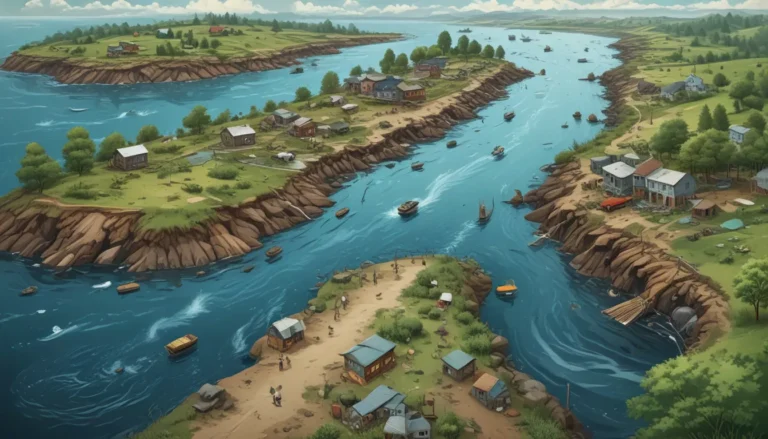A Note About Images: The images used in our articles are for illustration purposes only and may not exactly match the content. They are meant to engage readers, but the text should be relied upon for accurate information.
Welcome to the exciting world of index fossils, where ancient remnants hold the key to understanding Earth’s geological history. In this article, we will delve into the realm of paleontology and explore the fascinating realm of index fossils. These unique artifacts not only provide insight into the age of rock layers but also serve as valuable tools for scientists piecing together Earth’s intricate timeline. Get ready to be enthralled as we uncover 20 captivating facts about index fossils that will ignite your curiosity and deepen your appreciation for the wonders of our planet.
Unveiling the Enigma: Index Fossils Unraveled
Let’s begin by demystifying the concept of index fossils. Also known as guide fossils, these remarkable remnants are the preserved remains of plants or animals that inhabited specific time periods and enjoyed a wide geographic distribution. Geologists and paleontologists rely on index fossils to date and compare rock layers, unraveling the intricate tapestry of Earth’s geological past with precision and accuracy.
The Birth of Index Fossils: A Journey Through Time
Witness the birth of index fossils as ancient organisms are rapidly buried in sediment, eventually transforming into rock over the ages. The process of fossilization captures the essence of these creatures, preserving their shape and structure for us to study and admire. Through the study of index fossils, scientists embark on a journey through time, unraveling the evolutionary history of life on our planet.
The Anatomy of an Index Fossil: Key Characteristics
Discover the key criteria that define an index fossil:
– Distinctive features: Easily recognizable traits that simplify identification.
– Wide geographic distribution: Global presence for comparative study.
– Short-lived species: Brief existence pinpointing a specific era in history.
Navigating Through Time: Index Fossils in Relative Dating
Embark on a voyage through time with index fossils as your guide. These invaluable artifacts play a pivotal role in relative dating, enabling geologists to determine the age of rock layers in relation to one another. By examining the presence of specific index fossils, scientists unlock the secrets of Earth’s geological timeline, painting a vivid picture of the past.
Ammonites: The Iconic Index Fossil
Explore the world of ammonites, iconic index fossils that dominated the Mesozoic Era. With their distinctive spiral shells and widespread distribution, these marine creatures are perfect candidates for guiding scientists through the annals of time.
Trilobites: Guardians of the Paleozoic Era
Meet the ancient arthropods known as trilobites, stalwart guardians of the Paleozoic Era. Characterized by their three-lobed exoskeletons, these remarkable creatures provide invaluable insights into the past, serving as reliable markers for dating rock layers from their era.
Graptolites: Architects of the Marine World
Journey through the oceans of time with graptolites, extinct marine colonial animals that thrived from the Cambrian to the Carboniferous periods. Their intricate branching structures serve as signposts in Earth’s history, guiding scientists through the ancient seas of the past.
Microfossils: Tiny Marvels with a Mighty Impact
Delve into the world of microfossils, pint-sized artifacts with a colossal impact. These microscopic wonders, such as foraminifera and radiolarians, are instrumental in dating marine sediments, offering valuable insights into Earth’s geological past with their widespread distribution and abundance.
Index Fossils: Unveiling Earth’s Hidden Treasures in Oil Exploration
Embark on an expedition through Earth’s geological layers with index fossils as your compass. Beyond dating rocks, these remarkable artifacts play a vital role in oil exploration, guiding geologists to potential reservoirs and illuminating the path to valuable resources buried beneath the surface.
The Principle of Faunal Succession: A Guiding Light Through History
Unravel the principle of faunal succession, a cornerstone of index fossil analysis. Developed by the visionary geologist William Smith, this principle illuminates the chronological order of species throughout Earth’s history. By following the trail of index fossils, scientists correlate rock layers from diverse locations, stitching together a rich tapestry of Earth’s past.
Paleontological Niches: Insights Into Earth’s Ecosystems
Peer into the paleontological niches of the past with index fossils as your guide. These remarkable remnants offer a glimpse into the ecological roles of ancient organisms, shedding light on how ecosystems have evolved over millennia and offering valuable insights into the dynamics of Earth’s past.
Biostratigraphy: Unraveling Earth’s Geological Tapestry
Embark on a journey through biostratigraphy, a branch of geology dedicated to unraveling the succession of fossil organisms in rock layers. By deciphering the order in which species emerged and vanished, biostratigraphers construct intricate timelines of Earth’s geological history, painting a vivid portrait of the planet’s evolution through the ages.
Index Fossils and Evolution: Tracing the Path of Life on Earth
Peer into the annals of evolution with index fossils as your guide. By studying the changes in fossil organisms over time, scientists unlock the mysteries of diversification and extinction, tracing the intricate path of life on Earth and gaining profound insights into the forces that shaped our planet’s biological diversity.
Mass Extinctions: Echoes of Catastrophic Events
Uncover the echoes of mass extinctions marked by index fossils, such as the cataclysmic event at the end of the Cretaceous Period. Through the study of these artifacts, scientists unravel the causes and consequences of these devastating events, shedding light on how life rebounded and evolved in the aftermath of catastrophe.
Fossil Zones: Windows Into Earth’s Geological Timeline
Peer through the windows of fossil zones, intervals characterized by the presence of specific fossil species. These zones offer a glimpse into Earth’s past, serving as vital tools for correlating rock layers from diverse locations and constructing a detailed narrative of our planet’s geological history.
Index Fossils and Climate Change: A Glimpse Into Earth’s Climate History
Unlock the secrets of Earth’s climate history with index fossils as your guide. By analyzing the distribution of marine microfossils, scientists delve into ancient ocean temperatures and circulation patterns, offering valuable insights into past climate change events and enriching our understanding of Earth’s atmospheric dynamics through the ages.
Limitations of Index Fossils: Navigating Through Challenges
Navigate through the challenges of index fossils, including their limitations in dating and correlating rock layers. While these artifacts offer invaluable insights, their absence in certain formations can pose challenges in precise dating. Scientists must tread carefully, supplementing index fossils with additional data to paint a comprehensive picture of Earth’s history.
Fossil Assemblages: A Symphony of Prehistoric Life
Encounter the symphony of prehistoric life through fossil assemblages, groups of fossils that commonly occur together. These rich tapestries offer a holistic view of Earth’s past, painting a vivid portrait of the paleoecology of specific time periods and enriching our understanding of ancient ecosystems.
Absolute Dating: Bridging Relative and Absolute Time
Bridging the realms of relative and absolute dating, index fossils serve as crucial tools in constructing precise age estimates for rock layers. By combining these artifacts with absolute dating methods like radiometric dating, scientists unveil a detailed chronicle of Earth’s geological timeline, offering a comprehensive view of our planet’s evolutionary journey.
The Ever-Evolving Study of Index Fossils: A Glimpse Into the Future
Peer into the future of index fossils, a field of study that continues to evolve with each new discovery. As our understanding of Earth’s history expands, so too does our appreciation for the vital role index fossils play in unlocking the mysteries of our planet’s past. Join us on this exhilarating journey through time and witness the wonders of Earth’s geological history unfold before your eyes.
In Conclusion: Unlocking Earth’s Secrets With Index Fossils
In conclusion, the realm of index fossils offers a gateway to Earth’s rich geological history, illuminating the path of life through the ages. From dating rock layers to unraveling mass extinctions and climate change events, index fossils stand as beacons of knowledge, guiding scientists through the annals of time. Join us on this enlightening journey and witness the wonders of Earth’s past come to life through the remarkable lens of index fossils.
Was this page helpful?
We are committed to delivering trustworthy and engaging content that enriches your understanding of the world around you. Each fact on our site is contributed by real users like you, ensuring a diverse range of insights and information. Our dedicated editors rigorously review every submission to guarantee the highest standards of accuracy and reliability. Trust in our commitment to quality and authenticity as you explore and discover the wonders of the world with us.






